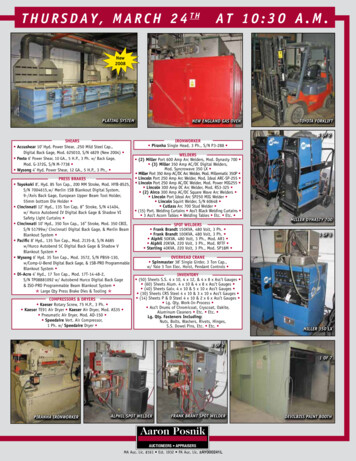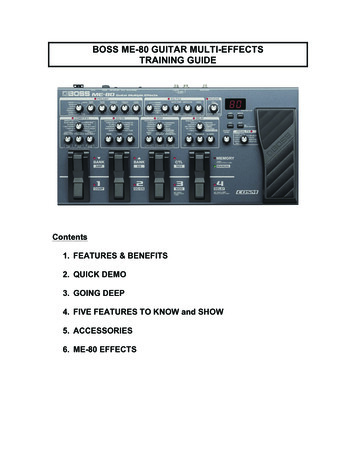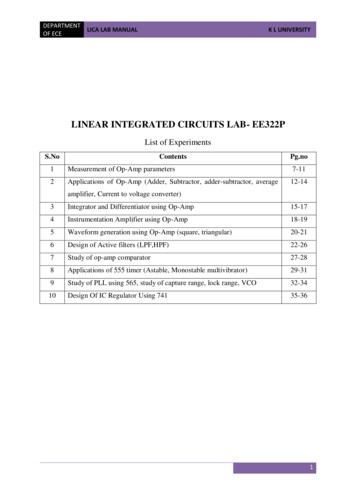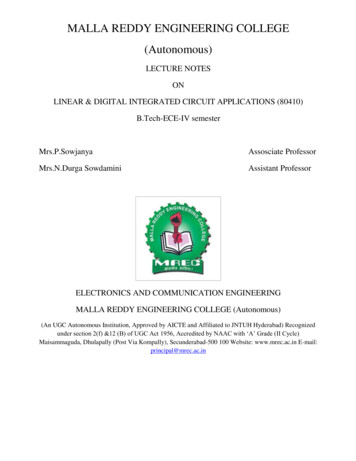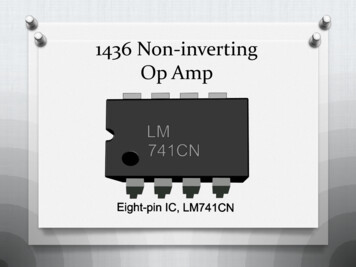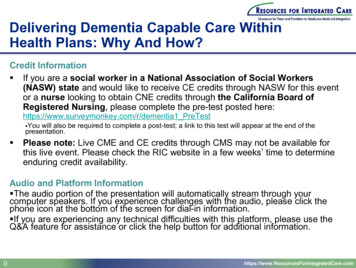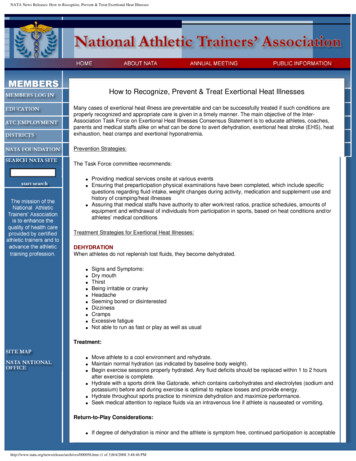
Transcription
NATA News Releases: How to Recognize, Prevent & Treat Exertional Heat IllnessesHow to Recognize, Prevent & Treat Exertional Heat IllnessesMany cases of exertional heat illness are preventable and can be successfully treated if such conditions areproperly recognized and appropriate care is given in a timely manner. The main objective of the InterAssociation Task Force on Exertional Heat Illnesses Consensus Statement is to educate athletes, coaches,parents and medical staffs alike on what can be done to avert dehydration, exertional heat stroke (EHS), heatexhaustion, heat cramps and exertional hyponatremia.Prevention Strategies:The Task Force committee recommends: Providing medical services onsite at various eventsEnsuring that preparticipation physical examinations have been completed, which include specificquestions regarding fluid intake, weight changes during activity, medication and supplement use andhistory of cramping/heat illnessesAssuring that medical staffs have authority to alter work/rest ratios, practice schedules, amounts ofequipment and withdrawal of individuals from participation in sports, based on heat conditions and/orathletes’ medical conditionsTreatment Strategies for Exertional Heat Illnesses:DEHYDRATIONWhen athletes do not replenish lost fluids, they become dehydrated. Signs and Symptoms:Dry mouthThirstBeing irritable or crankyHeadacheSeeming bored or disinterestedDizzinessCrampsExcessive fatigueNot able to run as fast or play as well as usualTreatment: Move athlete to a cool environment and rehydrate.Maintain normal hydration (as indicated by baseline body weight).Begin exercise sessions properly hydrated. Any fluid deficits should be replaced within 1 to 2 hoursafter exercise is complete.Hydrate with a sports drink like Gatorade, which contains carbohydrates and electrolytes (sodium andpotassium) before and during exercise is optimal to replace losses and provide energy.Hydrate throughout sports practice to minimize dehydration and maximize performance.Seek medical attention to replace fluids via an intravenous line if athlete is nauseated or vomiting.Return-to-Play Considerations: If degree of dehydration is minor and the athlete is symptom free, continued participation is /000056.htm (1 of 3)8/4/2008 3:48:46 PM
NATA News Releases: How to Recognize, Prevent & Treat Exertional Heat IllnessesEXERTIONAL HEAT STROKEA severe illness characterized by central nervous system (CNS) abnormalities and potentially tissue damageresulting from elevated body temperatures induced by strenuous physical exercise and increasedenvironmental heat stress.Signs and Symptoms: Increase in core body temperature, usually above 104 F/40 C (rectal temperature) when athlete falls illCentral nervous system dysfunction, such as altered consciousness, seizures, confusion, emotionalinstability, irrational behavior or decreased mental acuityNausea, vomiting or diarrheaHeadache, dizziness or weaknessHot and wet or dry skinIncreased heart rate, decreased blood pressure or fast breathingDehydrationCombativenessTreatment: Aggressive and immediate whole-body cooling is the key to optimizing treatment. The duration anddegree of hyperthermia may determine adverse outcomes. If untreated, hyperthermia-inducedphysiological changes resulting in fatal consequences may occur within vital organ systems (muscle,heart, brain, etc.). Due to superior cooling rates, immediate whole-body cooling (cold water immersion),is the best treatment for EHS and should be initiated within minutes post-incident. It is recommended tocool first and transport second if onsite rapid cooling and adequate medical supervision are available.Return-to-Play Considerations: The athlete’s physician should devise a careful return-to-play strategy that can be implemented with theassistance of a qualified health care professional.HEAT EXHAUSTIONHeat exhaustion is a moderate illness characterized by the inability to sustain adequate cardiac output,resulting from strenuous physical exercise and environmental heat stress.Signs and Symptoms: Athlete finds it hard or impossible to keep playingLoss of coordination, dizziness or faintingDehydrationProfuse sweating or pale skinHeadache, nausea, vomiting or diarrheaStomach/intestinal cramps or persistent muscle crampsTreatment: Remove athlete from play and immediately move to shaded or air-conditioned area.Remove excess clothing and equipment.Cool athlete until rectal temperature is approximately 101 F (38.3 C)Have athlete lie comfortably with legs propped above heart level.If athlete is not nauseated, vomiting or experiencing any CNS dysfunction, rehydrate orally with chilledwater or sports drink. If athlete is unable to take oral fluids, implement intravenous infusion of normalsaline.Monitor heart rate, blood pressure, respiratory rate, core temperature and CNS status.Transport to an emergency facility if rapid improvement is not noted with prescribed treatment.Return-to-Play Considerations: Athlete should be symptom free and fully hydrated; recommend physician clearance; rule outunderlying condition that predisposed him/her for continue problems; and avoid intense practice in heatuntil at least the next 6.htm (2 of 3)8/4/2008 3:48:46 PM
NATA News Releases: How to Recognize, Prevent & Treat Exertional Heat IllnessesHEAT CRAMPSMuscle cramps are not well understood. Heat cramps are often present in athletes who perform strenuousexercise in the heat. Conversely, cramps also occur in the absence of warm or hot conditions, which iscommon in ice hockey players.Signs and Symptoms: Intense pain (not associated with pulling or straining a muscle)Persistent muscle contractions that continue during and after exerciseTreatment: Reestablish normal hydration status and replace some sodium losses with a sports drink or waterSome additional sodium may be needed (especially in those with a history of heat cramps) earlier in theactivity.Light stretching, relaxation and massage of the involved muscle may help acute pain of a musclecramp.Return-to-Play Considerations: Athletes should be assessed to determine if they can perform at the level needed for successfulparticipation.EXERTIONAL HYPONATREMIAWhen an athlete’s blood sodium levels decrease, either due to overhydration or inadequate sodium intake, orboth, medical complications can result in cerebral and/or pulmonary edema. This tends to occur during warm/hot weather activities. Hyponatremia may be completely avoided if fluid consumption during activity does notexceed fluid losses.Signs and Symptoms: Excessive fluid consumption before, during and after exercising (weight gain during activity)Increasing headacheNausea, vomiting (often repetitive)Swelling of extremities (hands and feet)Treatment: If blood sodium levels cannot be determined onsite, hold off on rehydrating athlete (may worsencondition) and transport immediately to a medical facility.The delivery of sodium, certain diuretics or intravenous solutions may be necessary. All will bemonitored in the emergency department to ensure no complications develop.Return-to-Play Considerations: Physician clearance is strongly recommended in all cases. Prevent & Treat Heat IllnessesQuestions or comments about this web site, contact webdude@nata.orgCopyright 2003 National Athletic Trainers' Association. All Rights Reserved, 000056.htm (3 of 3)8/4/2008 3:48:46 PM
MSR AT Outreach ProgramHeat Illness Care ProtocolThe first step is identifying the condition. If the ATC is not present, a coach oradministrator is to contact him/her immediately in order to assess the level of severity.The primary goals of any heat illness are decrease core temperature, administer fluids toaid in thermoregulation, and minimize risk of systemic shock. The following protocolswill be implemented in the event of a heat illness at the time the ATC arrives.Heat cramps1.2.3.4.5.6.7.Assess level of illness (if thermometer is available take athlete’s temperature)Move athlete to a cooler location – rest him or her in a comfortable positionAdminister cool fluids every 15 minutesRemove or loosen tight clothing or athletic equipmentBegin gentle stretching of affected areasMonitor athlete closely for any changes in statusInstruct on 24 hour careHeat Exhaustion1. Assess level of illness (if thermometer is available take athlete’s temperature)2. Move athlete to a cooler location – rest him or her in a comfortable position, lyingdown with feet elevated if possible)3. Administer cool fluids every 15 minutes4. Remove or loosen tight clothing or athletic equipment and apply cool/wet towelsor sheets if fan is available or ice packs to neck, armpits, groin, wrists5. Monitor athlete closely for any changes in status6. Call 9-1-1 or the local emergency number if the person refuses water,vomits or loses consciousness.7. Based on level of severity, determine practice status in following sessions thatday8. Instruct on 24 hour care9. Athlete must check in with ATC the following day prior to any activity for reevaluationHeat Stroke1. Assess level of illness (if thermometer is available take athlete’s temperature)2. Check the ABC’sa. Airway – make sure the person’s airway is clear and not obstructedb. Breathing – make sure the person’s chest is rising and falling to indicatebreathingc. Circulation – check pulse – carotid, distal radial
3. Call 9-1-1 or your local EMS number immediately4. Move the athlete to a cooler location – rest him or her in a supine position withfeet elevated5. Quickly cool the body removing any athletic equipment, wrap wet sheets aroundthe body and fan it (box or oscillating fan if available)6. If you have ice packs or cold packs, place them on the athlete’s wrists andankles, in the armpits, groin, and neck to cool the large blood vessels7. Administer cool fluids if athlete is conscious8. Continue to monitor ABC’s and overall status9. Keep the person lying down and wait for EMS to arrive
RECOMMENDATIONS FOR HYDRATIONTO PREVENT HEAT ILLNESSTYPES OF SPORTS DRINKSSFluid Replacers§ Examples: Water, Gatorade, 10K, Quickick, Max§ These drinks are absorbed as quickly as water and typically are used for activities lasting less than2 hours.SCarbohydrate loaders§ Examples: Gatorlode, Exceed High, Carboplex§ These drinks replace more muscle glycogen to enhance greater endurance.§ They should be used after ultra-endurance events to increase muscle glycogen resynthesis afterexercise.SNutrition Supplements§ Examples: Gatorpro, Exceed Sports, Ultra Energy§ These supplements are fortified with vitamins and minerals and they help athletes maintain abalanced diet.§ They can be used as a meal replacement supplement for athletes who wish to skip a high fat meal,or as extra calories for athletes who wish to gain weight.WHAT NOT TO DRINKSDrinks with Carbohydrate (CHO) concentrations of greater than eight percent should be avoided.SFruit juices, CHO gels, sodas, and sports drinks that have a CHO greater than six to eight percent arenot recommended during exercise as sole beverages.SBeverages containing caffeine, alcohol, and carbonation are not to be used because of the high risk ofdehydration associated with excess urine production, or decreased voluntary fluid intake.
HYDRATION TIPS AND FLUID GUIDELINESSDrink according to a schedule based on individual fluid needs.SDrink before, during and after practices and games.SDrink 17-20 ounces of water or sports drinks with six to eight percent CHO, two to three hours beforeexercise.SDrink another 7-10 ounces of water or sport drink 10 to 20 minutes before exercise.SDrink early — By the time you’re thirsty, you’re already dehydrated.SIn general, every 10-20 minutes drink at least 7-10 ounces of water or sports drink to maintain hydration, and remember to drink beyond your thirst.SDrink fluids based on the amount of sweat and urine loss.SWithin two hours, drink enough to replace any weight loss from exercise.SDrink approximately 20-24 ounces of sports drink per pound of weight loss.SDehydration usually occurs with a weight loss of two percent of body weight ormore.WHAT TO DRINK DURING EXERCISESIf exercise lasts more than 45-50 minutes or is intense, a sports drink should be provided during thesession.SThe carbohydrate concentration in the ideal fluid replacement solution should be in the range of six toeight percent CHO.SDuring events when a high rate of fluid intake is necessary to sustain hydration, sports drinks with lessthan seven percent CHO should be used to optimize fluid delivery. These sports drinks have a fastergastric emptying rate and thus aid in hydration.SSports drinks with a CHO content of 10 percent have a slow gastric emptying rate and contribute todehydration and should be avoided during exercise.SFluids with salt (sodium chloride) are beneficial to increasing thirst and voluntary fluid intake as wellas offsetting the amount of fluid lost with sweat.SSalt should never be added to drinks, and salt tablets should be avoided.SCool beverages at temperatures between 50 to 59 degrees Fahrenheit are recommended for bestresults with fluid replacement.
DEHYDRATION, ITS EFFECTS ON PERFORMANCE,AND ITS RELATIONSHIP TO HEAT ILLNESSSDehydration can affect an athlete’s performance in less than an hour of exercise — sooner if the athlete begins the session dehydrated.SDehydration of just one to two percent of body weight (only 1.5-3 lb. for a 150-pound athlete) cannegatively influence performance.SDehydration of greater than three percent of body weight increases an athlete’s risk of heat illness (heatcramps, heat exhaustion, heat stroke).SHigh-body-fat athletes can have a harder time with exercise and can become dehydrated faster thanlower-body-fat athletes working out under the same environmental conditions.SPoor acclimatization/fitness levels can greatly contribute to an athlete’s dehydration problems.SMedications/fevers greatly affect an athlete’s dehydration problems.SEnvironmental temperature and humidity both contribute to dehydration and heat illnesses.SClothing, such as dark, bulky, or rubber protective equipment can drastically increase the chance ofheat illness and dehydration.SWet bulb temperature measurements should be taken 10-15 minutes before practice, and the resultsshould be used with a heat index to determine if practices or contests should be started, modified orstopped.SEven dry climates can have high humidity if sprinkler systems are scheduled to run before early morning practices start. This collection of water does not evaporate until environmental temperaturesincrease and dew points lower. Dry climate areas should take wet bulb and temperature readings 10to 15 minutes before practice or contests.SA Heat Index chart should be followed to determine if practice/contests should be held.SA Heat Index chart should come from a reputable source like the National Oceanic and AtmosphericAssociation.SA relative humidity of 35 percent and a temperature of 95 degrees Fahrenheit are likely to cause heatillness, with heat stroke likely.SA relative humidity of 70 percent and a temperature of 95 degrees Fahrenheit are very likely to causeheat illness, with heat stroke very likely.Journal of Athletic Training: 35(2): 212-224; NFHS Handbook Heat Related Illness, Sandra Shultz Phd,ATC, CSCS, Steven Zinder MS, ATC
Journal of Athletic Training2009;44(3):332–333g by the National Athletic Trainers’ Association, Incwww.nata.org/jatconsensus statementPreseason Heat-Acclimatization Guidelines forSecondary School AthleticsDouglas J. Casa, PhD, ATC, FNATA, FACSM*; David Csillan, MS, LAT, ATC*Inter-Association Task Force for Preseason Secondary School Athletics Participants: Lawrence E.Armstrong, PhD, FACSM ; Lindsay B. Baker, PhD ; Michael F. Bergeron, PhD, FACSM‰; Virginia M.Buchanan, JD ; Michael J. Carroll, MEd, LAT, ATCI; Michelle A. Cleary, PhD, LAT, ATCI; Edward R. Eichner,MD, FACSM ; Michael S. Ferrara, PhD, ATC, FNATAI; Tony D. Fitzpatrick, MA, LAT, ATCI; Jay R. Hoffman,PhD, FACSM, FNSCA"; Robert W. Kenefick, PhD, FACSM#; David A. Klossner, PhD, ATCI; J. Chad Knight,MSHA, MESS, ATC, OTCI; Stephanie A. Lennon, MS, NBCT, LAT, ATCI; Rebecca M. Lopez, MS, ATCI;Matthew J. Matava, MD** ; Francis G. O’Connor, MD, FACSM ; Bart C. Peterson, MSS, ATCI; Stephen G.Rice, MD, PhD, FACSM, FAAP ; Brian K. Robinson, MS, LAT, ATCI; Robert J. Shriner, MS, LAT, ATCI;Michael S. West, MS, ATCI; Susan W. Yeargin, PhD, ATCI*Co-Chairs; 3Individual Representatives; 4Gatorade Sports Science Institute; 1American College of Sports Medicine;INational Athletic Trainers’ Association; "National Strength and Conditioning Association; #United States ArmyResearch Institute of Environmental Medicine; **American Orthopaedic Society for Sports Medicine; 33AmericanMedical Society for Sports Medicine; 44American Academy of PediatricsAproper heat-acclimatization plan in secondaryschool athletic programs is essential to minimizethe risk of exertional heat illness during thepreseason practice period. Gradually increasing athletes’exposure to the duration and intensity of physical activityand to the environment minimizes exertional heat-illnessrisk while improving athletic performance. Progressiveacclimatization is especially important during the initial 3to 5 days of summer practices. When an athlete undergoesa proper heat-acclimatization program, physiologic function, exercise heat tolerance, and exercise performance areall enhanced.1–6 In contrast, athletes who are not exposedto a proper heat-acclimatization program face measurableincreased risks for exertional heat illness.For these reasons, the Inter-Association Task Force forPreseason Secondary School Athletics, in conjunction withthe National Athletic Trainers’ Association’s SecondarySchool Athletic Trainers’ Committee, recommends thatthese ‘‘Preseason Heat-Acclimatization Guidelines forSecondary School Athletics’’ be implemented by all secondary school athletic programs. These guidelines shouldbe used for all preseason conditioning, training, andpractice activities in a warm or hot environment, whetherthese activities are conducted indoors or outdoors. Whenathletic programs implement these guidelines, the healthand safety of the athletes are primary. However, therecommendations outlined here are only minimum standards, based on the best heat-acclimatization evidenceavailable. Following these guidelines provides all secondary school athletes an opportunity to train safely andeffectively during the preseason practice period.DEFINITIONSBefore participating in the preseason practice period, allstudent-athletes should undergo a preparticipation medical332Volume 44N Number 3 N June 2009examination administered by a physician (MD or DO) oras required/approved by state law. The examination canidentify predisposing factors related to a number of safetyconcerns, including the identification of youths at particular risk for exertional heat illness.The heat-acclimatization period is defined as the initial 14consecutive days of preseason practice for all studentathletes. The goal of the acclimatization period is toenhance exercise heat tolerance and the ability to exercisesafely and effectively in warm to hot conditions. Thisperiod should begin on the first day of practice orconditioning before the regular season. Any practices orconditioning conducted before this time should not beconsidered a part of the heat-acclimatization period.Regardless of the conditioning program and conditioningstatus leading up to the first formal practice, all studentathletes (including those who arrive at preseason practiceafter the first day of practice) should follow the 14-dayheat-acclimatization plan. During the preseason heatacclimatization period, if practice occurs on 6 consecutivedays, student-athletes should have 1 day of complete rest(no conditioning, walk-throughs, practices, etc).Days on which athletes do not practice due to ascheduled rest day, injury, or illness do not count towardthe heat-acclimatization period. For example, an athletewho sits out the third and fourth days of practice duringthis time (eg, Wednesday and Thursday) will resumepractice as if on day 3 of the heat-acclimatization periodwhen returning to play on Friday.A practice is defined as the period of time a participantengages in a coach-supervised, school-approved, sport- orconditioning-related physical activity. Each individualpractice should last no more than 3 hours. Warm-up,stretching, and cool-down activities are included as part ofthe 3-hour practice time. Regardless of ambient tempera-
ture conditions, all conditioning and weight-room activitiesshould be considered part of practice.A walk-through is defined as a teaching opportunity withthe athletes not wearing protective equipment (eg, helmets,shoulder pads, catcher’s gear, shin guards) or using othersport-related equipment (eg, footballs, lacrosse sticks,blocking sleds, pitching machines, soccer balls, markercones). The walk-through is not part of the 3-hour practiceperiod, can last no more than 1 hour per day, and does notinclude conditioning or weight-room activities.A recovery period is defined as the time between the endof 1 practice or walk-through and the beginning of the nextpractice or walk-through. During this time, athletes shouldrest in a cool environment, with no sport- or conditioningrelated activity permitted (eg, speed or agility drills,strength training, conditioning, or walk-through). Treatment with the athletic trainer is permissible.RECOMMENDATIONS FOR THE 14-DAY HEATACCLIMATIZATION PERIOD1. Days 1 through 5 of the heat-acclimatization periodconsist of the first 5 days of formal practice. Duringthis time, athletes may not participate in more than 1practice per day.2. If a practice is interrupted by inclement weather orheat restrictions, the practice should recommence onceconditions are deemed safe. Total practice time shouldnot exceed 3 hours in any 1 day.3. A 1-hour maximum walk-through is permitted duringdays 1–5 of the heat-acclimatization period. However,a 3-hour recovery period should be inserted betweenthe practice and walk-through (or vice versa).4. During days 1–2 of the heat-acclimatization period, insports requiring helmets or shoulder pads, a helmetshould be the only protective equipment permitted(goalies, as in the case of field hockey and relatedsports, should not wear full protective gear or performactivities that would require protective equipment).During days 3–5, only helmets and shoulder padsshould be worn. Beginning on day 6, all protectiveequipment may be worn and full contact may begin.A.B.5.Football only: On days 3–5, contact withblocking sleds and tackling dummies may beinitiated.Full-contact sports: 100% live contact drillsshould begin no earlier than day 6.Beginning no earlier than day 6 and continuingthrough day 14, double-practice days must be followedby a single-practice day. On single-practice days, 1walk-through is permitted, separated from the practiceby at least 3 hours of continuous rest. When a double-6.7.practice day is followed by a rest day, another doublepractice day is permitted after the rest day.On a double-practice day, neither practice shouldexceed 3 hours in duration, and student-athletesshould not participate in more than 5 total hours ofpractice. Warm-up, stretching, cool-down, walkthrough, conditioning, and weight-room activities areincluded as part of the practice time. The 2 practicesshould be separated by at least 3 continuous hours in acool environment.Because the risk of exertional heat illnesses during thepreseason heat-acclimatization period is high, westrongly recommend that an athletic trainer be on sitebefore, during, and after all practices.REFERENCES1. American College of Sports Medicine, Armstrong LE, Casa DJ, et al.American College of Sports Medicine position stand: exertional heatillnesses during training and competition. Med Sci Sports Exerc.2007;39(3):556–572.2. Bergeron MF, McKeag DB, Casa DJ, et al. Youth football: heat stressand injury risk. Med Sci Sports Exerc. 2005;37(8):1421–1430.3. Binkley HM, Beckett J, Casa DJ, Kleiner DM, Plummer PE. NationalAthletic Trainers’ Association position statement: exertional heatillnesses. J Athl Train. 2002;37(3):329–343.4. Casa DJ, Almquist J, Anderson S, et al. Inter-Association Task Forceon Exertional Heat Illness consensus statement. NATA News. June2003:24–29.5. Department of the Army and Air Force. Heat Stress Control andCasualty Management. Washington, DC: Dept of the Army and AirForce; 2003. Technical bulletin MED 507/AFPAM 48-152 (I).6. Wallace RF. Risk Factors and Mortality in Relation to Heat IllnessSeverity. Natick, MA: United States Army Research InstituteEnvironmental Medicine; 2003. Technical report T-03/14.DISCLAIMERThe National Athletic Trainers’ Association (NATA) and the InterAssociation Task Force for Preseason Secondary School Athletics adviseindividuals, schools, athletic training facilities, and institutions tocarefully and independently consider each of the recommendations.The information contained in the statement is neither exhaustive norexclusive to all circumstances or individuals. Variables such asinstitutional human resource guidelines, state or federal statutes, rules,or regulations, as well as regional environmental conditions, may impactthe relevance and implementation of these recommendations. TheNATA and the Inter-Association Task Force advise their membersand others to carefully and independently consider each of therecommendations (including the applicability of same to any particularcircumstance or individual). The foregoing statement should not berelied upon as an independent basis for care but rather as a resourceavailable to NATA members or others. Moreover, no opinion isexpressed herein regarding the quality of care that adheres to or differsfrom any of NATA’s other statements. The NATA and the InterAssociation Task Force reserve the right to rescind or modify theirstatements at any time.Journal of Athletic Training333
HeatIllnessPREVENT ION AND TREATMENT
Why Kids Are at Risk:1) Children absorb more heat from a hot environment than adults. Thesmaller the child the faster they heat up.12) Children release less heat through sweating .3) Children usually don’t drink2,3 enough fluids to replenish sweat lossesduring prolonged exercise .4) Young athletes may be more easily distracted when occasions allow forthem to rest and rehydrate.Signs of Dehydration and Heat Illness4, 5If dehydration progresses unchecked, the risk of heat illness increases. Heatillness is best understood in three separate degrees: HEAT CRAMPS, HEATEXHAUSTION and, the most serious and deadly form, HEAT STROKE. D E H Y D R AT I O N Dehydration during exercise is a common problem.Some young athletes can begin to suffer the consequences of dehydration ifthey become dehydrated by just 2 percent of their body weight. That’s whyit’s important to recognize the warning signs: What Puts Youth Athletes at Risk?Heat-related illnesses are some of the most common problems for youngathletes playing in the heat. These conditions can be dangerous or evenfatal in some cases. Heat-induced illness is one of the most preventablesports injuries. Parents, young athletes and coaches need to understandthe factors that increase the risk for heat-related illness and take steps toprevent it.Noticeable ThirstMuscle CrampsWeaknessDecreased PerformanceNausea HeadacheFatigueLightheaded feeling or dizzinessDifficulty paying attentionTreating the symptoms of dehydration is crucial in preventing more seriousconditions such as heat exhaustion.1) Rest in a cool place.2) Consume a sports drink that contains the adequate amount ofelectrolytes.3) Prevent dehydration in the future by consuming fluids before, duringand after exercise.4) Allow for ample time to rehydrate.
H E AT E X H A U ST I O N If dehydration goes untreated, the likelihoodof heat exhaustion may increase. Common symptoms of heat exhaustionare: Dizziness and fatigue Chills Rapid pulse H E AT ST R O K E Heat stroke is a medical emergency! When it isTreatment of heat exhaustion is similar to that of dehydration and shouldtake place immediately. This treatment includes:1)2)3)4)Rest in a cool, shaded area and place ice cold towels on the body. Drink a sports drink that contains the adequate amount of electrolytes. Lie down with legs elevated to promote circulation. Athlete should begin to feel better relatively soon; if not, assume heatstroke.not recognized promptly and treated properly, it can result in death. Ifrapid cooling does not occur, damage could be extreme, resulting in fatalconsequences. Symptoms and results of heat stroke include: Very high core body temperature Altered central nervous system function(i.e., confusion or unconsciousness) Otherwise healthy athlete collapsesduring intense exercise in the heatRemember that athletes get better relatively quickly with heat exhaustion,and they get worse with heat stroke. The important thing to remember isthat heat stroke must be treated immediately by doing the following: Immediate cool-down by whatever means possible An ice bath in a “cool pool” is preferable because of the superiorcooling rates (holding head out of bath) Ice packs over as much of the body as possible A cool shower Cool, wet towels Water spray SEEK MEDICAL ATTENTION IMMEDIATELY (always transport a suspectedheat stroke victim to the hospital). Do not drink fluids since nausea and vomiting are extremely common.
Hydration Game Plan2. Hydrate Before, During and After WorkoutsYoung athletes may not think dehydration will ever happen to them, but itcan — and if it does, parents, coaches and athletes had better know what todo about it. Proper hydration will help you perform at
S Drink fluids based on the amount of sweat and urine loss. S Within two hours, drink enough to replace any weight loss from exercise. S Drink approximately 20-24 ounces of sports drink per pound of weight loss. S Dehydration usually occurs with a weight loss of two percent of body weight or more. WHAT TO DRINK DURING EXERCISE


